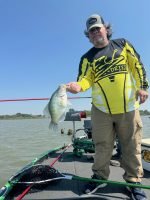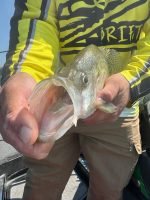Frank Haidusek holds proof that he knows how to catch 2-pound crappies
when he fishes Kansas reservoirs such as El Dorado. (Photo: Brent Frazee)
Kansas Pro Prefers Quality over Quantity
by Brent Frazee
Frank Haidusek stared at the screen of his Garmin Livescope and watched as an appealing picture of a big school of crappies materialized.
Then he kept moving, not seeing what he was looking for. Haidusek was after quality, not quantity. He found it on the far edge of the school—a big mark made by a big fish.
“In my experience, the big crappie tend to be by themselves,” Haidusek said as he fished El Dorado Lake in south-central Kansas. “Normally, they won’t be found in the middle of a school. They’re more like a lone wolf.”

Haidusek instructed David Zumbaugh, the fisherman he was guiding, to drop a plastic bait in front of the fish. It lazily swam up, took a look, then turned away. As it slowly retreated, Haidusek followed to give his guide client a second chance.
This time, it worked. The crappie bit, and the long fishing rod bent sharply. Seconds later, the 2.11-pound fish was in the boat and burped up a 6-inch shad as Haidusek unhooked it.
“That one was hungry,” Haidusek said as he weighed the crappie and tossed it back. “I guess she couldn’t resist just one more.”
Such is life for Haidusek, a nationally-known crappie pro who is the equivalent of a big-game hunter.
He isn’t satisfied with seeing how many fish he can catch. Whether he is competing in a national tournament or guiding (Cleared Hot Fishing) on El Dorado Lake, he searches for the biggest of the big.
On this trip in mid-May, several of those tanks were pulled into the boat. Haidusek weighed one other crappie that pushed 2 pounds, and several others that were between 1 ½ and 2 pounds.
He followed a consistent routine to find that success. While other anglers were pounding the banks during the crappie spawn, Haidusek was in 15 feet of water pursuing roaming fish.
He targeted a flat with scattered cover rather than going to a nearby section of the lake thick with timber and brush.
“It’s a lot easier to cover places with scattered timber and brush than coves where the cover is thick,” said Haidusek, who lives in Newton, Kan. “There are patches of timber just under the water here that most fishermen just pass by.
“I found it when the water was low and that timber was showing. I marked it and knew it would be good once the water came up.”
Some fishermen would assume that the water was too muddy to produce success. But in Haidusek’s eyes, it was just about ideal.
“Fishing across the country, I do my best in lakes that have dirty water,” he said. “Crappies can still see really well in those conditions. And you can get away with a lot more. You can get closer to the fish without spooking them.”
On this trip, he used 17-foot Todd Huckabee Carnivore rods to get baits away from the boat. He had 10 feet of line out to target fish suspended in 13 feet of water.

For his bait presentation, he used an Easy Drift Reaction Bait Ball on his line first to provide some scent, with a 1/16-th ounce Pro Built Game Changer jig head and Slab Shad plastic bait.
Then, he went on the hunt.
“You have to stay on the move,” he said. “You can’t sit in one place and wait for the fish to come to you.”
Even when Haidusek locates a big fish on his forward-facing sonar, he will chase it and give it several chances to hit.
“I’m always trying to adjust to see what they want,” he said. “I’ll have different rods rigged up with different sized baits, profiles and colors, plastics and hair jigs.
“Sometimes, they’ll turn on one bait and not hit, then I’ll try something a little smaller and they’ll bite. It can differ day to day.”
Other advice Haidusek offers:

- Don’t get caught in the trap of thinking all crappies spawn along the banks in murky water. He has caught spawning fish in 4 to 8 feet of water, relating to timber or brush. “One time, I was off-shore and caught a male that was just black (in its spawning colors),” he said. “The next cast, I caught the female that was dropping eggs when I brought her into the boat.”
- Haidusek often starts deep, about 20 feet of water, then works his way shallower to find larger crappies.
- The big ones often are suspended and not necessarily holding to cover. In fact, some of the biggest crappies Haidusek has caught were roaming.
- Don’t overwork your baits. With the help of Garmin Livescope, Haidusek often holds his jig almost motionless in front of the fish. “You don’t want a lot of jigging movement,” he said. “It looks unnatural to the fish.”
- Target the murkiest water. That’s often the most fertile water and will hold the largest concentrations of shad.
- Stay on the move. Look for the biggest marks and stay on them. Haidusek has used his trolling motor to chase fish as far as 800 feet.
- Be adaptable. Try to match the profile of your bait to the size of the shad the crappies are eating.
Haidusek used that formula to catch his personal best crappie, a fish that weighed 3.80 pounds, at Lake Grenada in Mississippi
“It looked so big on the screen that I thought it was a carp,” he said.
Haidusek got the fish to bite and pulled it into the boat, then released it as he does with all large crappies he catches.
There was only one problem.
“I was pre-fishing for a tournament,” he said with a smile. “I could have used that one a day later.”
Brent Frazee is an award-winning writer and photographer who retired after 36 years as the outdoors editor of The Kansas City Star. He continues to freelance for magazines, websites and newspapers He lives on a lake in a suburb of Kansas City, Mo. with his wife Jana and his two yellow labs Millie and Maggie.


